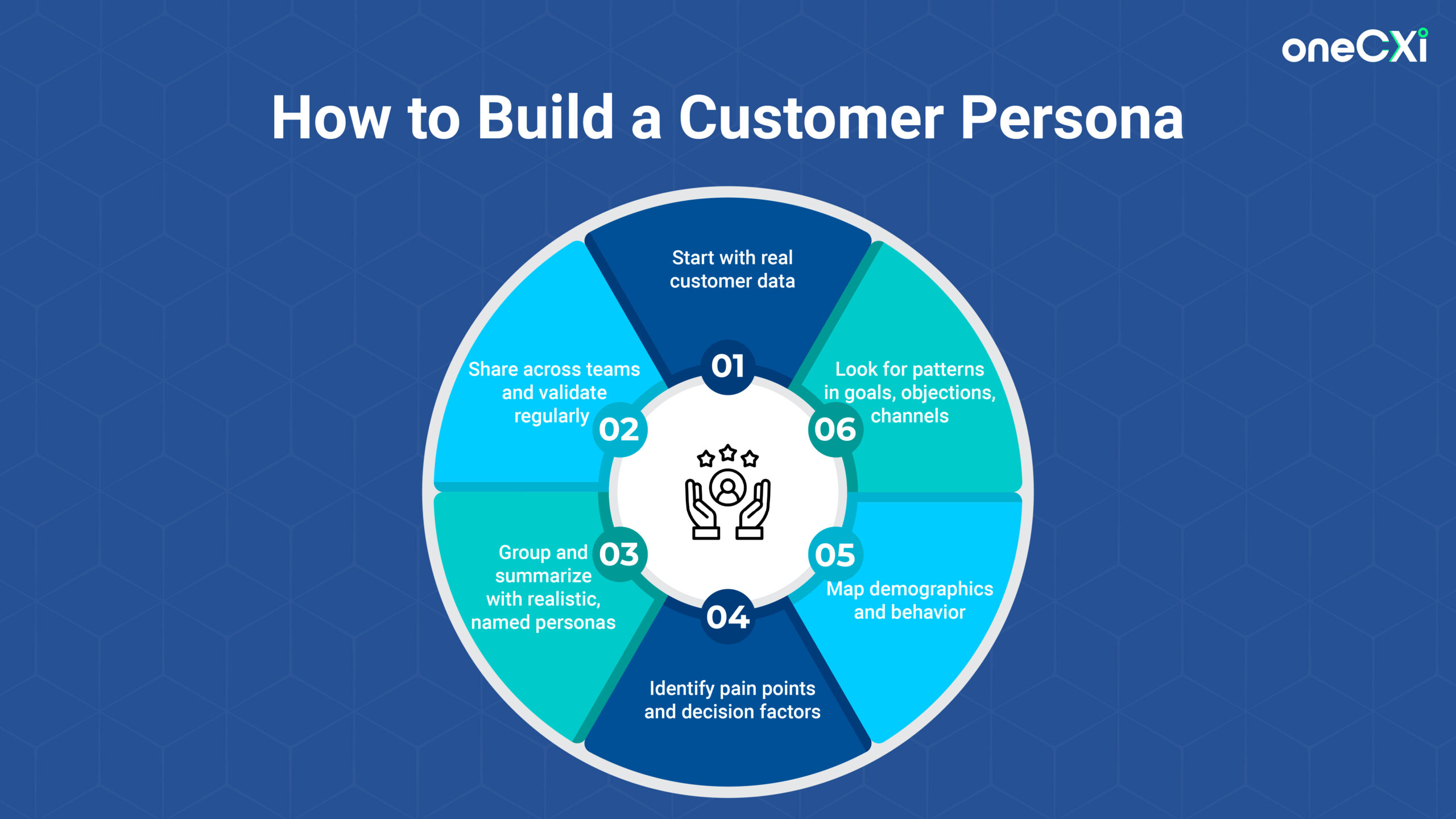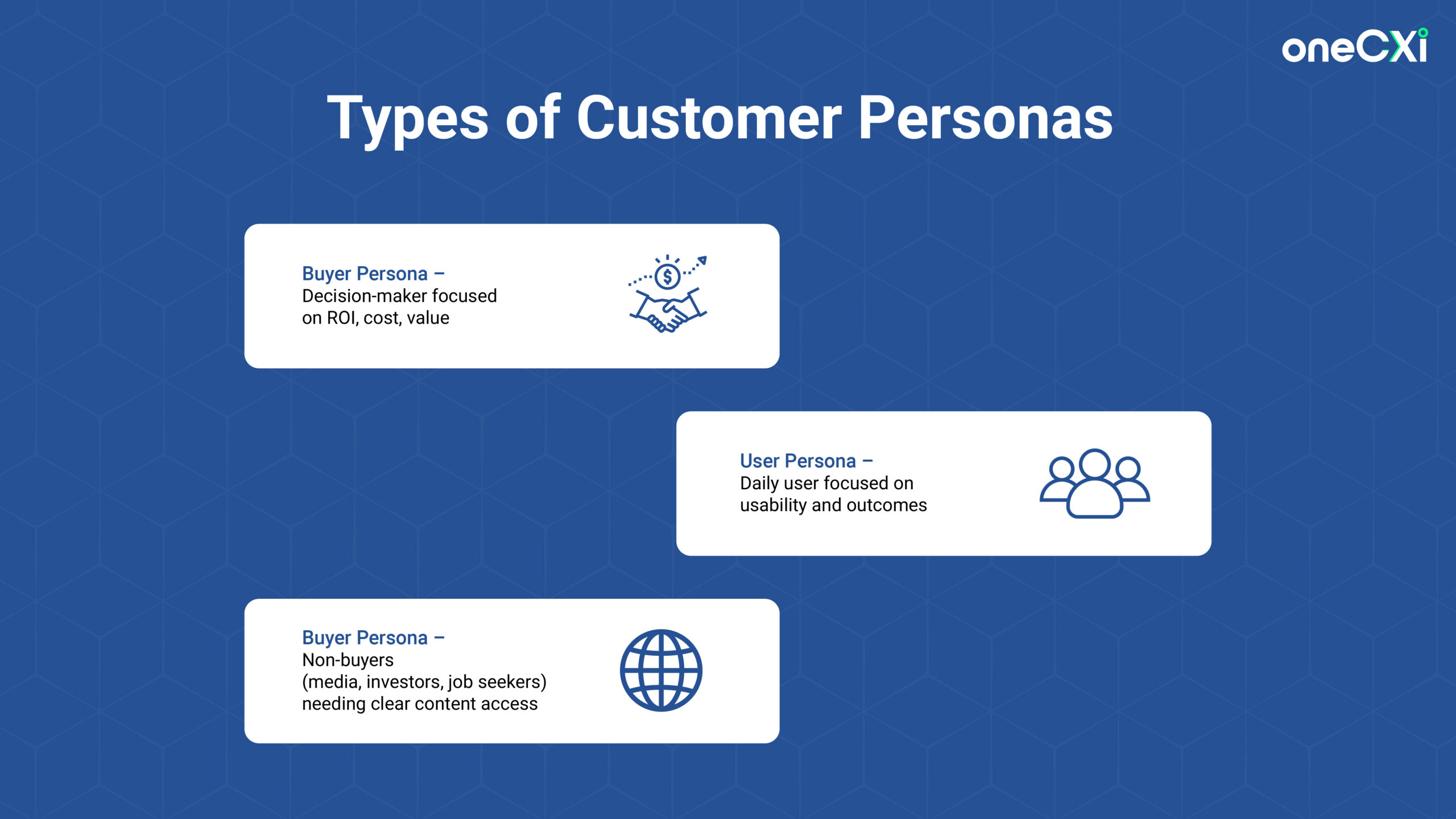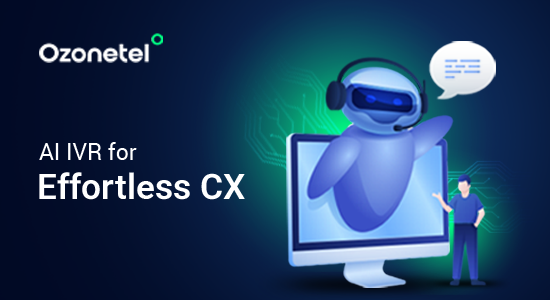- Resources
- What is a Customer Persona? Definition, Uses, and Examples
What is a Customer Persona? Definition, Uses, and Examples

You’ve probably heard the phrase “know your customer” a thousand times. But most teams don’t go beyond surface-level info. They rely on broad segments—such as age, job title, or maybe a pain point or two—and then make a lot of assumptions. That’s a problem.
Because assumptions lead to wasted time, irrelevant messaging, and offers no one responds to.
That’s where customer personas make a difference. They give you a way to dig deeper to understand not just who your audience is, but why they make the choices they do. A well-made persona brings clarity to your content, sales strategy, product roadmap, and even customer support.
Let’s break down what a customer persona really is, how to build one, and how to actually use it to guide your decisions.
What is Employee Experience?
Employee Experience (EX) is the overall perception employees have of their journey within an organization. It encompasses every interaction and touchpoint, from recruitment and onboarding to daily responsibilities, support systems, and eventual offboarding.
What Is a Customer Persona?
A customer persona is a detailed profile that describes one specific type of customer you want to attract, convert, and retain. It goes beyond basic facts like job title or industry by answering questions like:
- What are they trying to achieve?
- What’s holding them back from getting there?
- What do they look for when choosing a product or service?
- Who influences their decision?
- What frustrates them in their current process?
This is the kind of insight that helps you speak to real customer needs, rather than using vague messaging that no one can relate to.
Why Are Customer Personas Important for Your Business Success?

Here’s a detailed look at why customer personas matter, how they directly impact different areas of your business, and why skipping this step can lead to weak results.
1. You build for real people, not assumptions
A customer persona gives you a clear picture of who you’re targeting, not just their age or job title, but their daily challenges, goals, expectations, and what influences their decisions. Without this, you’ll likely create generic campaigns or product features that miss the mark.
When you talk to real customers, study support tickets, and track user behavior, you start seeing clear patterns. You understand:
- What triggers them to search for a solution
- What objections do they raise during a sales call
- What convinces them to convert
You’re no longer building based on what you think they want; you’re building based on what they’ve shown and told you.
2. You improve targeting across all channels
You’ll stop wasting time and ad spend on people who were never the right fit. Personas help you segment your audience by what actually matters: their intent, priorities, and pain points.
You can:
- Group users by their buying goals (like value seekers vs. premium buyers)
- Target ads more precisely based on what that segment responds to
- Tailor outreach depending on where they are in their buying journey
Instead of blasting the same message to everyone, you deliver the right message to the right people, and it shows in your conversion rates.
3. Your content becomes more relevant
Without clear personas, you risk writing blogs or creating social posts that nobody engages with. But once you know your customer personas well, you can speak their language and address what matters to them directly.
For example:
- You know the problems they’re actively trying to solve
- You know what tone and level of detail they expect
- You know which examples or case studies will feel relatable
That relevance makes your messaging more useful, and that’s what keeps people reading, clicking, and coming back.
4. Sales and support teams stop guessing
When your sales and support teams understand your different customer types, they handle conversations with more clarity. They know what questions to ask, which features to highlight, and how to manage expectations.
For example, a sales rep talking to a time-strapped manager will focus on simplicity and speed. But for a persona that’s more technical or budget-conscious, the rep can walk through long-term value and return on spend.
Your support team also benefits. If they know which persona is more likely to raise certain types of tickets, they can be proactive in how they communicate and solve problems faster.
5. You spot gaps in your product or offering
When you build personas based on real feedback, patterns start to show. You might find that a certain segment always looks for a feature you don’t yet have, or that they drop off because your pricing doesn’t suit their budget structure.
These insights help you:
- Prioritize product improvements based on actual user demand
- Test new packages, features, or trial flows for different personas
- Stop building things that don’t solve a real problem
Instead of relying on internal assumptions, you shape your roadmap based on the people you want to serve, and that keeps your product aligned with what the market actually wants.
6. You reduce drop-offs and churn
When your messaging, customer onboarding , and product experience match what customers expect, they’re more likely to stick around. Personas help you create that match.
You’ll:
- Identify friction points early
- Build better onboarding for different user types
- Offer features or support that suit specific needs
The result? Fewer people give up midway, and more of them find value in your offering long term.
How to Create a Customer Persona?

Here’s a comprehensive step-by-step process to build customer personas that actually help your sales, marketing, and product teams make better decisions.
1. Talk to Your Actual Customers
Begin with your current customers, as they already buy from you, so it makes sense to study what they have in common. To do this:
- Look into your CRM (Customer Relationship Management system) or wherever you store customer information. Note job titles, industries, company sizes, and regions.
- Talk to your sales and support teams. Ask them about common patterns they see in the people they deal with.
- Review your email list, order history, or online form responses—anything that can show recurring traits.
- Identify people who frequently engage with your business: repeat buyers, frequent support requesters, etc.
2. Identify Common Patterns Across Customers
Now that you have an initial idea of who your customers are, it’s time to go deeper. Here are some ways to do this:
- Interview your existing customers, especially the ones who are happiest with your product. Ask open-ended questions:
- What problem were you solving when you found us?
- What made you pick us instead of other options?
- How did you discover us?
- What almost stopped you from buying?
- Use surveys for a wider reach. Keep them short (10–15 questions) and ask specifics about what they were looking for, what mattered most, and what nearly pushed them away.
3. Map Out Demographics and Behaviors
Now that you understand the “why” behind customer decisions, add useful demographic and behavioral details. Stick to what helps you make better marketing or product choices, not trivia.
Include:
- Job title and role: What do they actually do at work?
- Industry or segment: What field do they work in?
- Company size (if B2B): Are they at a startup or an enterprise?
- Location: Are they local, national, or global?
- Age range: Only if it affects buying behavior.
- Income range: Especially if it influences pricing sensitivity.
- Experience level: Are they beginners or experts?
- Tools and platforms they use: Especially those related to your product.
- Preferred content channels: Do they spend time on LinkedIn, YouTube, or newsletters?
- Buying process: Do they conduct thorough research? Who else is involved in the decision?
4. Define the Customer’s Goals and Pain Points
Customer personas are useless if they only cover surface-level facts. You need to understand their mindset. Ask questions such as:
- What goals are they trying to achieve?
- What problems keep coming up in their work?
- What makes their job harder?
- What kind of solution would actually make a difference?
- What do they feel frustrated or annoyed by in current options?
5. Review and Connect the Dots
Once you’ve collected all this input, look for patterns. Don’t force-fit the information—just observe what naturally repeats. For example:
- Are most buyers team leads or decision-makers?
- Do they care more about cost, performance, or ease of use?
- Are they trying to fix a broken system or just looking for something better?
- What are the most common deal breakers?
- What channels are they using to research or reach out?
6. Create Clear, Specific Personas
Now it’s time to build actual profiles. If you sell to more than one type of buyer, create separate personas for each.
Each persona should include:
- A name (to make it relatable)
- Job title or role
- Industry and company size
- Main goals or responsibilities
- Biggest challenges or blockers
- What they look for when buying
- How do they make decisions
- Where do they go to research
- The objections they typically raise
7. Share It with Teams and Use It Often
Once the personas are ready, make sure your sales, marketing, product, and support teams are on the same page.
- Give them real quotes from the interviews to help them understand the customer mindset.
- Use the persona to adjust your messaging, pitch, and support experience.
- Let teams test different approaches with each persona and gather feedback.
8. Revisit and Update It Regularly
Personas are not static. If you keep using the same one for years, you’ll miss new patterns. Instead:
- Set a time every few months to review your personas.
- Talk to a fresh batch of customers.
- Ask your team what’s changed—have the objections shifted? Are buyers coming from new industries or job roles?
Customer Segments vs. Personas
When you’re trying to understand your audience, it’s easy to confuse customer segments with personas. Both help you group your potential customers, but they serve different purposes and provide different levels of detail. Here’s how they compare across different factors:
| Aspect | Customer Segments | Customer Personas |
|---|---|---|
| Definition | Groups of customers categorized based on shared characteristics like demographics, geography, behavior, or purchase history | Detailed fictional characters that represent a specific type of user within a segment; includes their goals, pain points, and behaviors |
| Purpose | Helps you understand and target broad market categories for strategic planning | Helps you humanize your audience and create personalized communication, product design, and experiences |
| Data Type | Based on quantitative data, such as age, location, average spend, purchase frequency, etc. | Based on a mix of quantitative and qualitative data, includes psychographics like motivations, decision-making habits, frustrations, etc. |
| Focus | Focuses on what people do and who they are demographically | Focuses on why people do what they do—what influences their behavior and decisions |
| Scope | Broader and more general; used to divide a large market into smaller groups | Narrower and more specific, zooms in on a representative individual from within a segment |
| Usage Across Teams | Helpful for marketing and product teams to prioritize segments and allocate resources | Used across marketing, product, sales, and support teams to personalize user journeys, messaging, onboarding, and more |
| How it’s Built | Usually built using CRM (Customer Relationship Management) data, surveys, and analytics tools | Built using interviews, customer feedback, surveys, behavioral data, support transcripts, and observational research |
| Flexibility | More rigid—segments don’t change frequently unless market conditions change | More adaptable—personas can evolve as you collect more insights and customer behavior shifts |
So, which one should you use?
You actually need both.
- Use customer segments to identify the different types of people or businesses you’re serving at a high level.
- Use personas to understand the behaviors and motivations of individuals within those segments.
They work best when combined. Segments help you target the right groups, and personas help you speak to them in a way that actually connects. Together, they help you make smarter marketing decisions, build better products, and create more meaningful customer experiences.
Types of Customer Personas

When people talk about customer personas, most assume it’s just one profile: a single representation of the “ideal customer.” That’s far from accurate. If you’re selling a product or service, there are often multiple people involved in the buying process, and each of them interacts with your brand in different ways.
Here are the three main types of personas you should build and how each plays a distinct role in how your business connects with people.
1. Buyer Persona
The buyer persona is the person who makes the purchase decision. They either directly pay for your product or sign off on the purchase. They’re responsible for budgets, and they’re thinking in terms of return on investment, long-term value, and business needs.
You should build this persona to:
- Guide your marketing and sales messaging
- Identify the key decision criteria (e.g., cost, speed, reliability)
- Understand the buying cycle, including how long they take to make a decision and what slows them down.
Why it matters: If you don’t speak directly to this persona’s priorities, your product might be great, but they’ll still walk away. You need to give them a clear reason to choose you over other options, and they need to believe your solution will meet their business goals.
Example: A Head of Procurement at a logistics company decides on a fleet tracking tool. They won’t use the tool every day, but they’re the ones who evaluate vendors and approve the deal.
2. User Persona
The user persona is the person who actually uses your product. They care less about ROI and more about usability, speed, simplicity, and results. These personas help you shape your product’s features, design, and customer support.
You should build this persona to:
- Understand daily challenges, pain points, and workflows
- Identify which features matter most and which ones they ignore
- Improve onboarding and support materials to match real use cases
Why it matters: If your product is hard to use or doesn’t solve the actual problem the user faces, even the best marketing won’t help. Users will complain, adoption will drop, and eventually, the buyer will hear about it, leading to churn.
Example: A dispatch manager using the fleet tracking tool to assign routes, monitor delivery times, and flag issues in real time.
3. Website Persona
This is often overlooked. A website persona represents the different people who visit your website, not all of whom are buyers or users. Think of job seekers, investors, media, partners, researchers, or industry peers. While they might not buy your product, they influence your brand perception and may impact your reach in ways that matter.
You should build this persona to:
- Structure your navigation, content, and CTAs (calls to action) clearly
- Make it easy for each group to find what they came for
- Balance the needs of different visitors without overwhelming any one group
Why it matters: If all your messaging is focused only on the buyer or user, the site may confuse or frustrate others who are also important to your business. A clean, focused experience for each type of visitor improves credibility and helps avoid friction.
Example: A VC investor visiting your site to learn about your traction or a job seeker trying to understand your culture and team.
Examples of Effective Customer Personas
Here are a few examples of well-defined customer personas to give you clarity on what they should look like and how they help across teams.
1. Growth-Focused Startup Founder
Who they are: Founder or co-founder of a tech startup, usually in the early growth stage
Age: 28–40
Location: Tier 1 cities or global hubs (e.g., Bengaluru, San Francisco)
Goals:
- Get early traction and prove product-market fit
- Keep acquisition costs low
- Build awareness within a specific niche
Challenges:
- Limited budget for paid marketing
- Juggling multiple roles (product, marketing, hiring)
- Need quick wins to show progress to investors
Where this helps:
- Build short-form, tactical content like growth hacks or success stories
- Offer startup-friendly pricing or onboarding support
- Use founder-centric messaging like “Move fast with clarity.”
2. Enterprise IT Decision-Maker
Who they are: CIO, Head of IT, or Procurement Manager at a large organization
Age: 40–55
Location: Global
Goals:
- Make secure and scalable tech choices
- Reduce downtime and risk
- Ensure vendor compliance and data privacy
Challenges:
- Slow procurement cycles
- Cross-functional stakeholder management
- Risk-averse decision-making
Where this helps:
- Focus your messaging on security, compliance, and ROI
- Provide detailed case studies, whitepapers, and security documentation
- Tailor outreach around pain points like vendor audits or downtime risks
3. Independent E-commerce Seller
Who they are: Individual or small team running a store on Shopify, Amazon, or other marketplaces
Age: 25–38
Location: Mostly metro/tier 2 cities
Goals:
- Increase online visibility
- Reduce manual work (inventory, reconciliation, order processing)
- Stay competitive on price
Challenges:
- Low margins
- No dedicated team for marketing or ops
- Struggles with platform changes (like ad policy updates or algorithm shifts)
Where this helps:
- Offer easy-to-use tools with clear onboarding
- Position content around automation and small-business support
- Create YouTube or WhatsApp-based support options
Conclusion
Customer personas are a practical way to understand your audience, align your team, and make decisions that actually speak to your users. Without them, you risk guessing what your audience wants and wasting time on strategies that don’t work.
When you define clear personas, your content, campaigns, and product decisions become more focused. You stop creating for everyone and start creating for the people who are most likely to engage, convert, and stay loyal.
If you haven’t built detailed customer personas yet, it’s worth doing now. Start small, validate them with real customer data, and use them across teams — from marketing to product to support.
Conclusion
When EX is strong, employees are engaged, motivated, and less likely to leave, which means less turnover, more productivity, and a culture people want to be part of. Leaders who invest in EX aren’t just keeping up with trends; they’re actively setting their companies up for a competitive edge in attracting and keeping top talent.
Take a close look at your current EX. Where are the gaps? What could be done better? Small improvements today can create a lasting impact tomorrow. A positive employee experience doesn’t just improve work for your team—it drives real results that lift the whole organization. So, let’s get moving on building an EX that truly shines.
Start your EX journey today by conducting employee surveys, implementing flexible work arrangements, and investing in employee development.
Discover how detailed personas can help you boost retention and build loyalty
Frequently Asked Questions
Start by collecting information through interviews, surveys, support tickets, and website analytics. Identify patterns in goals, pain points, behavior, and preferences. Group similar responses into segments, then build a detailed profile for each one, including demographics, buying triggers, objections, and content preferences.
Personas help you target the right people with the right message. Instead of broad campaigns, you can focus on what each segment actually cares about, which improves engagement, lowers acquisition costs, and increases conversions. They also help you avoid generic content that doesn’t lead to action.







